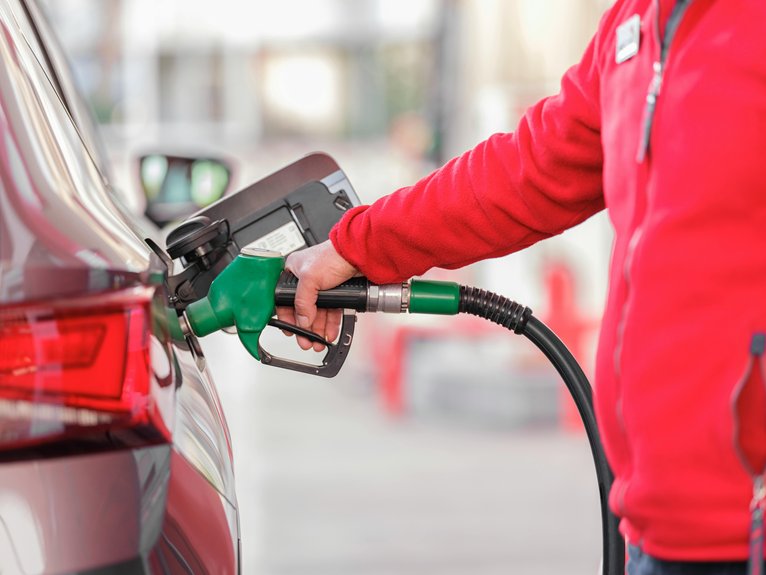Your vehicle’s miles-per-gallon plummets the moment you enter city limits. Each red light, stop sign, and traffic jam creates an efficiency nightmare for your engine, forcing it to burn excess fuel during frequent acceleration cycles. The constant brake-throttle-brake pattern disrupts your car’s ideal operating state, preventing it from reaching the sweet spot of fuel economy. But don’t surrender to poor MPG as an inevitable urban driving tax—practical techniques and simple vehicle adjustments can help you reclaim those lost miles and reduce your visits to the pump.
The Science Behind Urban Fuel Consumption
While highway driving typically delivers ideal fuel economy, urban environments present unique challenges that greatly impact your vehicle’s MPG. Your engine operates most efficiently at steady speeds with consistent load, conditions rarely found in city traffic.
The physics is straightforward: each stop requires energy conversion from motion to heat via brakes, wasting accumulated kinetic energy. Accelerating from standstill demands maximum fuel delivery as your engine works against inertia. Modern vehicles mitigate this through start-stop systems and regenerative braking.
Additionally, shorter trips prevent your engine from reaching peak operating temperature, forcing it to run rich fuel mixtures. Cold engines increase friction between components and reduce combustion efficiency.
Urban environments also involve more idling—a state where you’re burning fuel while gaining zero miles traveled, dramatically reducing your MPG calculations.
Traffic Signals and Stop Signs: Your MPG’s Worst Enemy
Every red light and stop sign represents a direct hit to your vehicle’s fuel economy. When you brake, kinetic energy transforms into heat and dissipates through your brake pads—energy that’s completely wasted.
Your engine then requires substantial fuel to accelerate back to cruising speed, consuming 35-60% more fuel during acceleration phases compared to steady-state driving.
Modern vehicles equipped with start-stop technology mitigate some losses, but they can’t eliminate the inefficiency of repeatedly accelerating from zero. Each full stop can reduce your MPG by up to 0.2 miles, which accumulates quickly in grid-pattern cities with traffic control at most intersections.
Traffic signal timing compounds this problem—lights programmed for ideal traffic flow rather than fuel efficiency force unnecessary deceleration and acceleration cycles, creating the notorious “accordion effect” that decimates fuel economy.
Idling Away Your Gas Money: The Hidden Cost
Although many drivers focus on movement-related fuel consumption, idling represents a significant yet often overlooked drain on your gas tank.
Modern fuel-injected engines consume 0.2-0.5 gallons per hour while idling, effectively delivering 0 MPG during these periods.
In urban environments, you’ll typically idle for 15-20% of your drive time—at traffic lights, drive-thrus, and during gridlock.
This translates to roughly 10-12 gallons wasted annually for the average commuter. The financial impact compounds when fuel prices spike.
Engine start-stop technology mitigates this issue, but if your vehicle lacks this feature, consider manually shutting off your engine when stopped for more than 30 seconds.
Contrary to popular belief, restarting creates less wear and uses less fuel than extended idling.
Smart City Driving Techniques That Save Fuel
Since acceleration events demand the most fuel in urban driving, mastering efficient throttle control forms the foundation of fuel-saving techniques.
Apply gradual pressure to the accelerator, aiming for smooth, progressive power delivery rather than abrupt inputs that waste fuel.
Anticipate traffic flow by scanning 10-15 seconds ahead. This foresight allows you to maintain momentum through green lights and gradually decelerate when stopping becomes inevitable.
When approaching red lights, release the throttle early and coast—modern fuel injection systems cut fuel flow during deceleration.
Maintain a consistent speed whenever possible, as your engine operates most efficiently within its ideal RPM range.
Use cruise control on longer urban stretches to eliminate the micro-adjustments that increase consumption.
Finally, select routes with fewer stops and synchronous traffic signals to minimize acceleration cycles altogether.
Vehicle Maintenance for Optimal Urban Efficiency
While driving techniques dramatically impact fuel economy, your vehicle’s mechanical condition plays an equally significant role in urban efficiency. Proper tire inflation alone can improve MPG by up to 3%, critical during stop-and-go driving where rolling resistance compounds.
Maintain scheduled oil changes with manufacturer-recommended viscosity—thicker oil creates parasitic drag on city-cycle cold starts. Replace clogged air filters promptly; a restricted airflow forces your engine to work harder during acceleration cycles.
Don’t ignore oxygen sensors; deteriorated sensors cause fuel mixture imbalances that waste gas during constant speed adjustments. Check for dragging brakes, which silently consume power and fuel at every intersection.
Modern engine control units adapt to mechanical deficiencies by richening fuel mixtures. This compensation maintains driveability but sacrifices efficiency—especially devastating in urban environments where your powertrain already operates at its least efficient regime.
Route Planning Strategies to Maximize Fuel Economy
Because urban environments present complex traffic patterns, strategic route planning becomes essential for maximizing fuel economy.
Utilize navigation apps with real-time traffic data to avoid congestion points and identify routes with synchronized traffic lights. Timing matters—scheduling trips during off-peak hours can reduce stop-and-go driving by up to 40%.
Consider elevation changes when planning routes; climbing steep hills consumes considerably more fuel than gradual inclines. A route with consistent speeds, even if slightly longer, often delivers better MPG than shorter paths with frequent stops.
Batch your errands geographically rather than making multiple separate trips—a cold engine in its first 5-10 minutes operates at peak inefficiency.
For hybrid vehicles, prioritize routes with regenerative braking opportunities to capitalize on energy recovery systems during city driving.
Conclusion
You’ll greatly improve your urban fuel economy by mastering the traffic flow dance. Don’t underestimate how proper throttle modulation and maintaining momentum between lights preserves kinetic energy. Your vehicle’s efficiency hinges on anticipatory driving techniques rather than reactive responses. Combine strategic route planning with regular maintenance protocols, and you’ll extract maximum MPG despite the city’s inherent inefficiencies. The difference isn’t marginal—it’s measurable at every fill-up.



